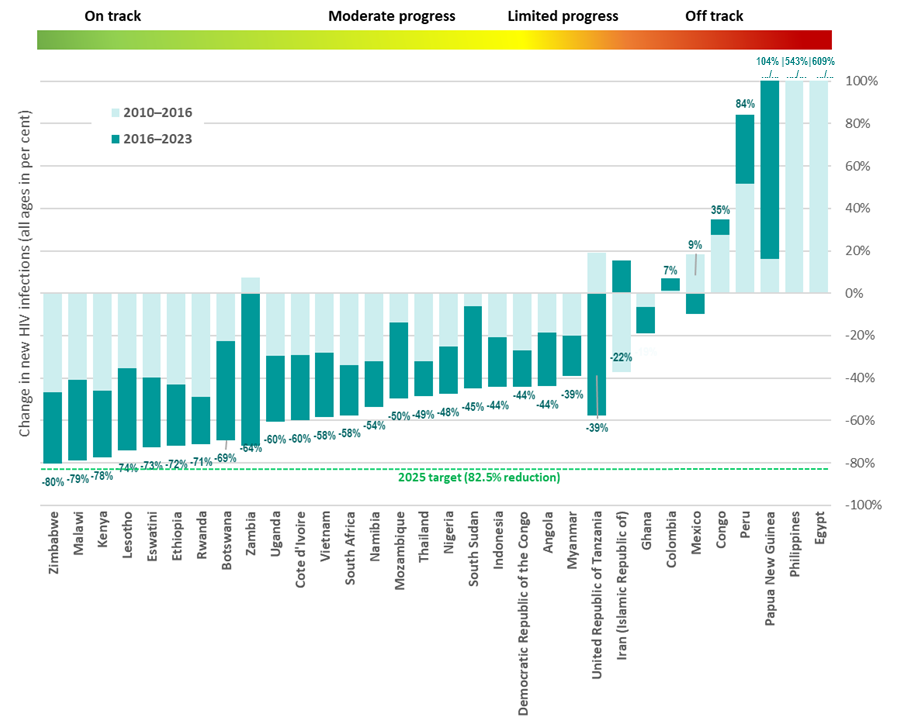This quarter has been focused on data, science and pre-exposure prophylaxis (PrEP) for the Global HIV Prevention Coalition (GPC); the launch of the 2024 Global AIDS Update, Global Fund HIV report, release of PURPOSE 1 study results on lenacapavir, a promising long-acting prevention option, the announcement of PURPOSE 2 trial results, launch of the WHO Implementation tool provider module and as well as key strategic engagements across partners, regions and countries – read the detailed update below.
The Urgency of HIV Prevention now

According to the 2024 Global AIDS Update: The Urgency of now: AIDS at a crossroads launched in July, an estimated 1.3 million people acquired HIV in 2023, which is three times more than the target of fewer than 370 000 by 2025. Of the GPC countries, eight have reduced their annual new infections by 66% compared to 2010. Majority urgently need to accelerate efforts to achieve targets.
A significant unmet need for resources for HIV prevention and societal enabler programmes in almost all regions persists. In 2023, an estimated US$ 2.4 billion was available for primary prevention programmes in low- and middle-income countries far below the USD 9.5 billion required in 2025. Increasing investments is critical to closing the gap. Read more.
Launch of the Global Fund HIV report
This report provides insights into the progress made in implementing HIV interventions in the Global Fund supported countries. It highlights the increased investments in HIV prevention from US$705 million over the 2018-2020 period to more than US$870 million over the 2021-2023 period. The investments in HIV prevention over this period are focused on the urgent need to close gaps in access to the interventions in the prevention toolkit including pre-exposure prophylaxis, post-exposure prophylaxis, condoms and lubricants, harm reduction programmes for key and priority populations.
HIV Prevention at AIDS 2024
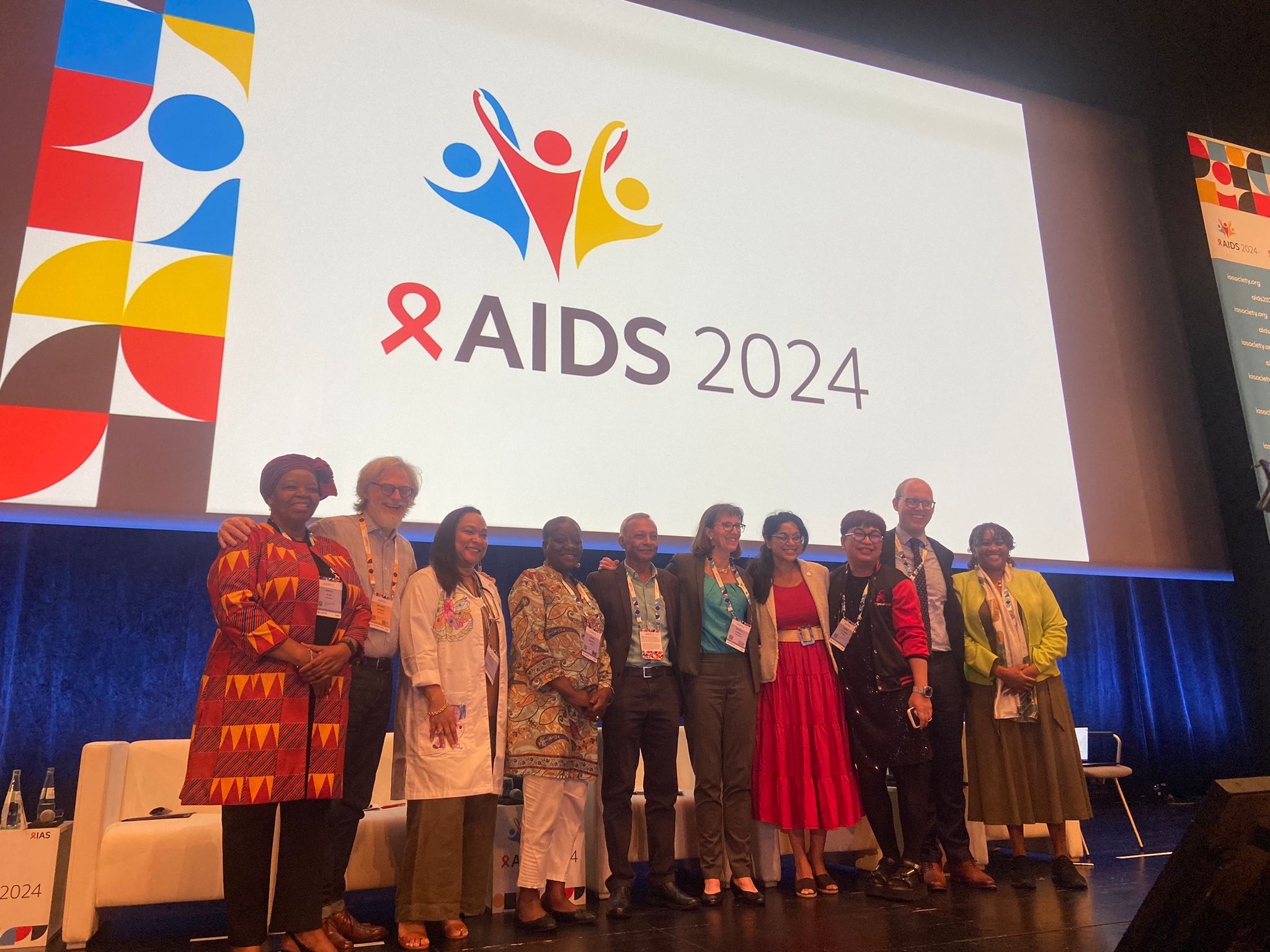
Several coalition partners held HIV prevention sessions, at the International AIDS Conference (AIDS2024), this year, in Munich including the launch of key strategic documents and announcements aimed at advancing the prevention programming to meet the 2025 targets and beyond. A highlight was the presentation of the PURPOSE 1 Trial results on lenacapavir – a promising prevention option; UNAIDS, AVAC, WHO and other partners welcomed the results and are working with Gilead to ensure that it is cost effective, available, accessible to all populations, globally.
The GPC hosted a people-centered differentiated session that emphasized the need for both prevention and treatment in reaching global targets; and launched an HIV Prevention Learning Pack, a compendium of essential resources for designing and managing HIV prevention responses at country and community levels. The Children’s Investment Fund Foundation (CIFF), in partnership with the Global Fund to Fight AIDS, Tuberculosis and Malaria (the Global Fund), announced an initiative of up to US$2 million over the 2024-2025 period for the purchase of approximately 150,000 dapivirine vaginal rings in countries that implement Global Fund grants to fight HIV and AIDS.
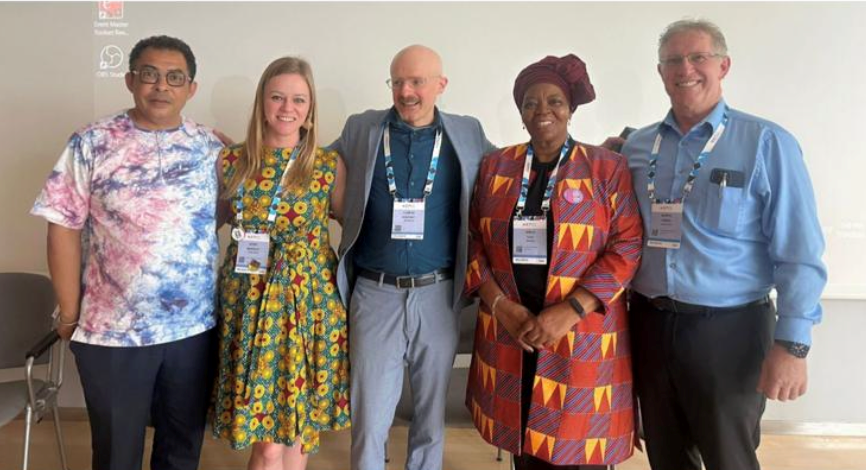
WHO, U.S. Centers for Disease Control and Prevention, UNAIDS, EpiC Project, PATH and the International AIDS Society partnered to host a satellite session at AIDS 2024 entitled: Achieving scale and equity: models to simplify, normalize, and diversify PrEP service delivery to spotlight real-world PrEP service delivery models from a variety of contexts and for different populations. Experts from CDC Kazakhstan, CDC Jamaica, Love Yourself Inc. from Philippines, University of Malaysia, and Kyanamukaka Health Center III in Uganda presented a variety of innovative models that exemplified out-of-the box thinking, from community-based PrEP starter packs to pharmacy-based PrEP to fully virtual service delivery. The session concluded with a call to action to urgently scale these and models globally to promote equitable PrEP access among all those who May benefit from it.
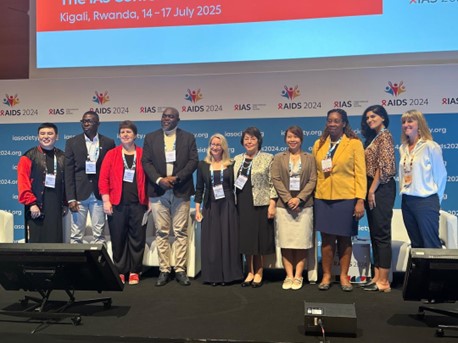
Prevention Outcome Monitoring Workshop
The South-to-South HIV Prevention Learning Network (SSLN) and the Global Prevention Coalition, together with UNAIDS, the Global Fund, WHO, PEPFAR and the Government of Botswana, hosted the HIV Prevention Outcome Monitoring Workshop in Gaborone Botswana on 16-18 September. This workshop brought together 150 participants, including representatives from 21 countries in Africa and Asia, as well as global stakeholders and technical experts involved in HIV prevention outcome monitoring.
In their opening remarks, Her excellency Goitsemang Morekisi (Ministry of State President from Botswana) who gave appreciation to the SSLN, stating that "SSLN has become a necessity in our HIV agenda, especially as connecting us as a global community” and Prof Sheila Tlou from the GPC, who captured the importance of HIV prevention outcome monitoring, in the statement "We can accomplish great things, but if we don’t document then we can’t learn and share for future generations to see what we did".
The workshop gave participants an opportunity to learn about available guidance and tools on HIV prevention outcome measurements, share and learn from country experiences with HIV prevention outcome monitoring, draft country prevention outcome monitoring plans, as well as kick-start implementation of the tools included in the Global Fund's Prevention Outcome Monitoring Toolkit.
GPC highlights
The GPC welcomed trial results from PURPOSE 2 and looks forward to the release of full results from PURPOSE 2. The Coalition called for rapid and thorough guidelines and approval processes to be made new long-acting options available – along-side existing PrEP options, condoms, contraceptives, harm reduction and other effective HIV and sexual health services for women and men in settings with high HIV as well as key populations.
Strengthening Stewardship for HIV Prevention programmes in Zambia through the GPC Support teams
A statement by the HIV Multisector Leadership Forum on Country vision on sustainability to the UNAIDS Programme Coordinating Board.
New prevention options: A focus on PrEP
Long-acting injectable lenacapavir: In late June 2024, Gilead Sciences announced an early review of the data of the PURPOSE 1 trial by an independent monitoring board, which found that injectable lenacapavir (LEN) provided as a prevention method was safe and highly effective against HIV. The trial involved about 5338 HIV-negative cisgender women aged 16-25 years in Uganda and South Africa. No HIV acquisitions were seen among those receiving LEN. This advocates’ primer provides further background on the product and trials, raises key questions, and explores next steps. And it is now being updated based on the positive results of the PURPOSE 2 trial among other populations. Download the Lens on LEN report, and listen to an accompanying podcast here: Lenacapavir: The case for investing in delivering HIV prevention.
Long-Acting PrEP Status Update: This long-acting PrEP status update is revised on a quarterly basis by AVAC, Secretariat to the Coalition to Accelerate Access to Long-Acting PrEP, to synthesize the current status of long-acting PrEP products. This is done in service to the wider ecosystem. The dashboard includes graphics pertaining to the regulatory approvals, volumes, ongoing and planned implementation science studies, and non-profit prices for currently available long-acting PrEP products (currently injectable cabotegravir and dapivirine vaginal ring), along with an overview of the emerging information about injectable lenacapavir.
HIV Self-Testing and PrEP: WHO and AVAC released HIV Self-Testing and PrEP: Opportunities for scale-up to address common misconceptions about the use of HIV self-testing (HIVST) for PrEP initiation and continuation while highlighting the opportunities that HIVST can provide in order to support further scale-up of this important self-care option.
WHO Pre-exposure prophylaxis (PrEP) Implementation tool: WHO launched the Provider Module for Oral and Long-Acting PrEP. Based on the latest evidence, the module integrates clinical service delivery guidance to support implementations for all 3 WHO recommended PrEP products: oral PrEP; the dapivirine vaginal ring; and long acting injectable cabotegravir. It provides practical support and important considerations for the safe and effective PrEP provision by a range of providers, including physicians, nurses, clinical officers, community health workers, pharmacists and lay and peer providers, in either clinical or community settings.
PrEP and Adolescent Girls and Young Women: UNICEF, the Global Fund and AVAC released Pre-ExposureProphylaxis and Adolescent Girls and Young Women in Eastern and Southern Africa: The latest insights that summarizes the most recent evidence on AGYW PrEP provision.

Empowering Adolescent Girls and Young Women for HIV Prevention in Zimbabwe
Development Agenda for Girls and Women in Africa Network (DAWA) and My Age Zimbabwe embarked on a transformative initiative funded by VIIV Healthcare to enhance the health and well-being of Adolescent Girls and Young Women (AGYW) between the ages of 15 and 24 in Masvingo Province, Zimbabwe. The key components of the project included: establishing self-care clubs and training in Sexual Reproductive Health and Rights (SRHR) including oral PrEP, PEP, and the Dapivirine Ring, using digital strategies such as social media (WhatsApp) on mobile smartphones to facilitate science dialogues and information exchange on HIV prevention and enhance outreach and documentation. Read more
Sexual Reproductive Health and Integration
On 10 September UNESCO’s Dakar office hosted a meeting of the Joint Regional Team on AIDS in West and Central Africa. This was the first time that the regional cosponsors met out of UNAIDS office and UNESCO was proud to welcome their peers. A highlight of the meeting was the presentation of a study by the EVA Network on prevention among adolescents living with HIV in Burkina Faso and Senegal. Results show that teachers are their first source of information on SRH, and that 79% did not address SRH issues with their parents. Only 11% shared their HIV status with friends or acquaintances, and even less with their parents. The results were taken onboard by the working group on Prevention, Youth and Education.
As a part of CASPR, Copper Rose Zambia and AVAC launched a new resource addressing the critical need for integrated SRH and HIV services. This Sexual and Reproductive Health Integration Advocacy Roadmap provides key steps for success, focusing on collaboration, strategic mapping and targeted advocacy.
Renewed global action on female genital schistosomiasis (FGS) paves the way for HIV/SRHR integration
The FGSIntegration Group (FIG), co-chaired by Frontline AIDS and Unlimit Health, brought ministries of health, civil society and community voices from endemic countries together to share experiences and challenges on integrating female Genital schistosomiasis (FGS) service delivery with HIV and SRHR.
The event, co-organized by the World Health Organization (WHO), heard community and clinical experiences of FGS and examples of successful integration models in Cote d’Ivoire, Kenya, Madagascar and Malawi. Recommendations from the discussion included the need to: change the narrative of FGS from a neglected disease to a women’s rights and SRH condition; look at all entry points for integration and ensure there is global leadership and coordination on FGS for countries to follow. Read the policy brief for key recommendations to tackle FGS.
Stakeholder Engagement for Developing a Comprehensive Health Sector Acceleration Plan for HIV Prevention in Adolescents and Young People (AYP) in Ghana
This 1-day consultation meeting organized by UNAIDS and UNICEF Ghana aimed at gathering valuable insights and contributions from adolescents, young people, and key partners, while also exploring the specific needs, challenges, and gaps in current HIV prevention efforts for AYP to strengthen collaboration across partners for a unified and more effective approach to HIV prevention efforts targeting adolescents and young people. Participants included key prevention stakeholders in government, non-governmental and civil society organizations. This engagement is a critical step towards building a more inclusive and responsive HIV prevention strategy for adolescents and young people in Ghana.
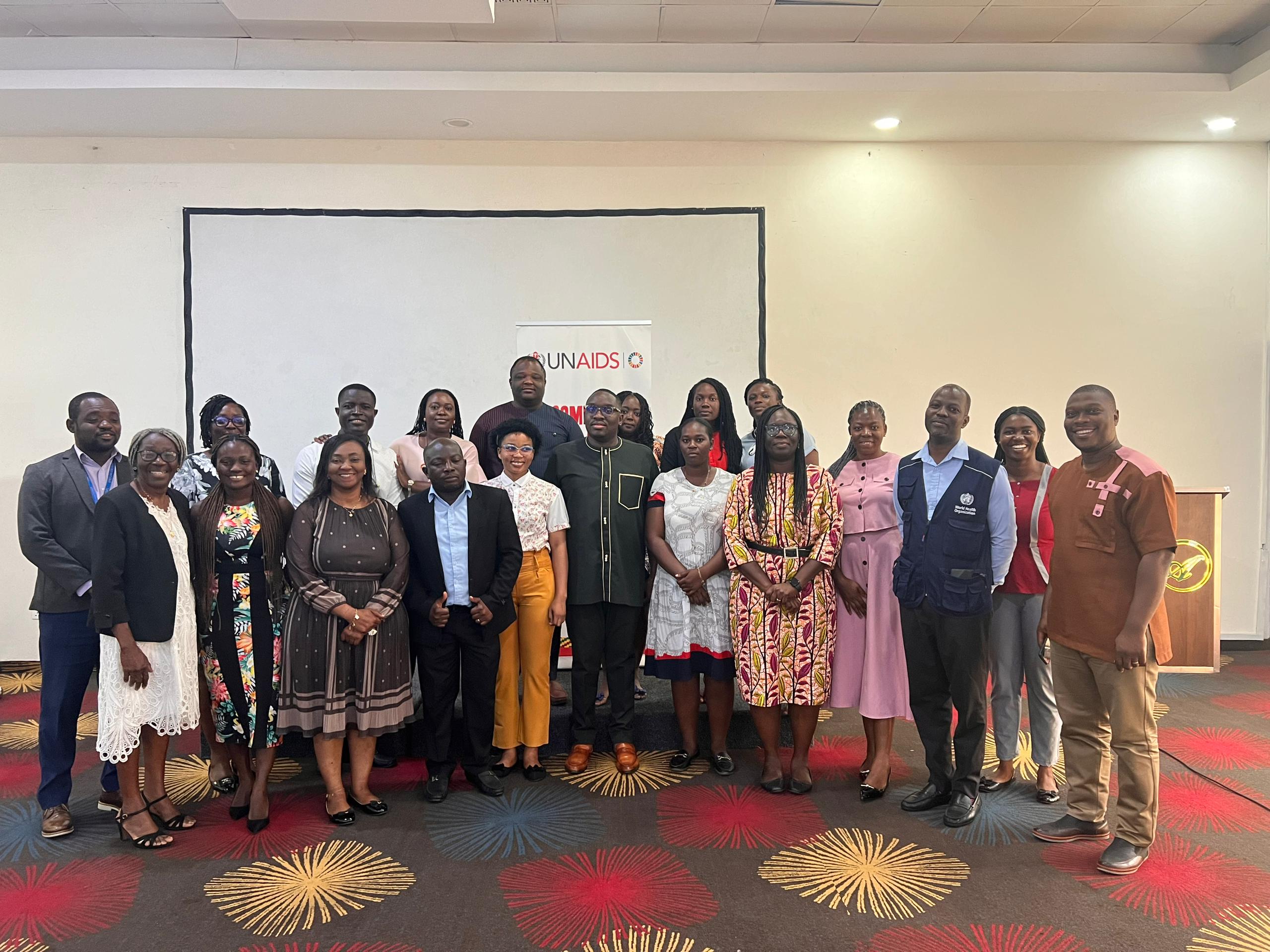
Addressing gender barriers in accessing HIV services for men
In its’ 10th webinar, themed, “Breaking Barriers and Bridging Gaps: Addressing Gender and Age Disparities in HIV Services for Men”, the Men & HIV Technical (MENHT) Working Group held strategic discussions on how gender norms, societal expectations, and demographic factors contribute to disparities that hinder effective HIV interventions among men and explored actionable solutions. Download the webinar resources.
Accelerating HIV and STIs prevention for young people from key populations in Asia and the Pacific
This initiative was led by UNAIDS, WHO and Youth Lead in Bangkok, Thailand, from 24-26 September 2024 and aimed to find practical solutions to expand HIV and STIs prevention access, acceptability and uptake for adolescents and young people from key populations in the Asia-Pacific countries. Young people, government representatives, WHO and UNAIDS country offices, and/or other key partners attended from Bangladesh, Cambodia, China, India, Indonesia, Lao PDR, Myanmar, Nepal, the Philippines, Thailand and Viet Nam. Countries developed draft actionable roadmaps to advance key HIV and/or STI prevention gaps within the countries.
Strengthening HIV Prevention stewardship through GPC country support teams
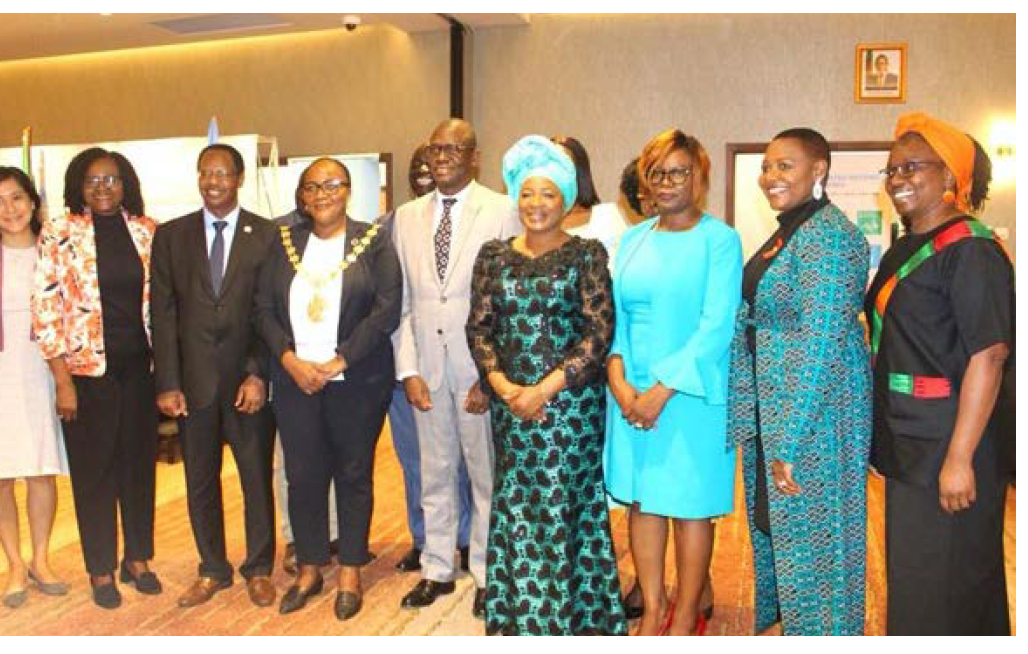
In Zambia, the Global HIV Prevention Coalition is providing technical support to National AIDS Commissions in form of two National United Nations Volunteers (UNVs) one positioned at the National AIDS Commission office and the other at the UNAIDS County Office. Together, these prevention champions form part of the GPC country support teams and strive to strengthen national capacity and the systems for managing implementation of an effective HIV prevention response towards attaining the 2025 targets.
Addressing gaps in domestic financing for the HIV response in Africa
UNAIDS issued a press release highlighting the launch of two key strategic reports ahead of the summit of the future on, “Domestic revenues, debt relief and development aid: Transformative pathways for ending AIDS by 2030” focusing on eastern and southern Africa and west and central Africa. The reports highlight the impact of tax, debt, and development assistance on HIV and health investments, offering updated data and solutions. Using granular country data, they call for increased international support, tax collection, and debt relief, and emphasize urgent reforms in global financial architecture and SDG financing.
Did you know? Adjusted for inflation, eastern and southern Africa will need to mobilize $10.5 billion in 2024 to fund the HIV response. This will climb to $15.84 billion by 2030.
Governments and global partners reaffirm their commitment to end AIDS
At the summit of the future, heads of state, government officials and global partners reaffirmed their commitment to ending AIDS as a global public health threat by 2030. The first two commitments focused on scaling up HIV prevention and treatment and reducing number of new HIV infections to zero through prioritization of sexual comprehensive sexual and reproductive health education, support the use of pre-exposure prophylaxis (PrEP), and invest in harm reduction strategies to reduce new HIV infections by 90%. Download the full commitments.
Celebrating united action on HIV prevention!
As the Frontline AIDS’ United for Prevention (U4P) programme wraps up, a remarkable set of outcomes and achievements to date include implementation of the advocacy strategies with significant results by civil society organizations in seven high HIV prevalence countries - Kenya, Malawi, Mozambique, Nigeria, Tanzania, Uganda, and Zimbabwe. Kenya’s coalition influenced the government to roll-out CAB-LA with input from communities, and in Nigeria, the coalition advocated for the inclusion of community distribution of naloxone, an anti-overdose drug, to be included in Nigeria’s National Strategic Plan. Country coalitions have also used joint action plans to target spaces to demand progress on reducing HIV infections, particularly amongst marginalized communities.
The coalitions have learnt and shared valuable skills, which they’ve used to develop HIV Prevention and Accountability Reports, a civil society perspective on progress against targets in the Global HIV Prevention 2025 Roadmap. These reports are pivotal tools for ongoing community-led advocacy on HIV prevention. Sustainability plans are in place to support each national coalition to continue its advocacy work after the programme ends. Stay tuned for further learnings from the programme as well as detailed country profiles.
High-Level Meeting on Harm Reduction Programming and National Steering Committee meeting for People Who Use and Inject Drugs in the Republic of Malawi
United Nations Office on Drugs and Crime (UNODC), alongside stakeholders, facilitated ahigh-level meeting on Harm Reduction programming in Malawi. The meeting addressed critical issues and advancements in addressing HIV among People Who Use and Inject drugs (PWUID), highlighting an alarming 27% HIV prevalence in this population and the urgent need for multifaceted interventions. Key stakeholders, including PEPFAR, the Global Fund, and International Agencies who provide technical support, such as UNODC, are actively involved in efforts focusing on scaling up evidence-based harm reduction services and spear heading key advocacy activities on this issue.
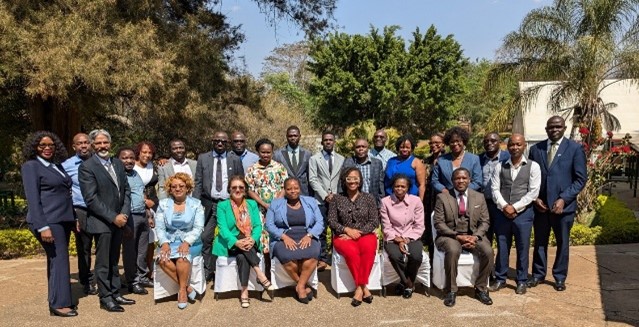
The National Steering Committee on People Who Use and Inject Drugs (PWUID) Programming convened at the United Nations Development Programme (UNDP) Offices in Lilongwe to discuss harm reduction programming in Malawi. This important meeting was needed to strategize for the scaling up of harm reduction programming in Malawi. UNODC, in collaboration with local stakeholders and law enforcement, will work to tackle structural barriers preventing scaling up of harm reduction programming and increasing focus on the magnitude of these health issues. Additionally, UNODC will engage in high-level advocacy with SADC, African Union and Global Fund for harm reduction support and organize a side event at the next Commission on Narcotic Drugs. The National Steering Committee meeting for PWUID was an important activity to accelerate harm reduction programming in Malawi, providing stakeholders with a valuable opportunity to analyze and discuss pertinent issues.
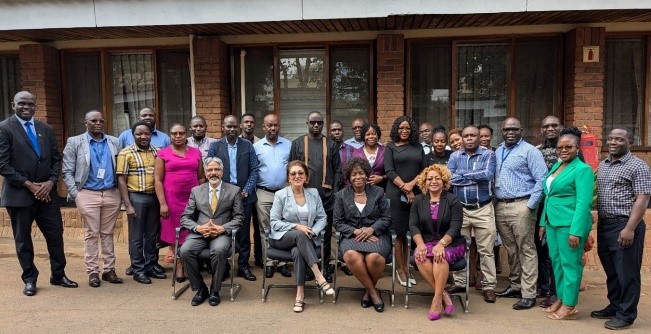
High-level meeting for Harm Reduction Programming in the Republic of South Africa
The high-level meeting on harm reduction programming aimed to enhance the implementation of evidence-based harm reduction strategies in South Africa. Discussions focused on scaling up opioid substitution therapy, needle and syringe programmes, price of methadone, naloxone, and addressing challenges such as limited resources and systemic barriers to scaling up harm reduction. Presentations highlighted the urgent need for a comprehensive approach to drug use disorders, improving integration of services, and addressing human rights violations against people who use and inject drug. A field visit to harm reduction programme sites including prisons, in Mamelodi, Pretoria for the group of friends was also conducted.

Ensuring quality health care by reducing HIV-related stigma and discrimination
WHO launched a technical brief that outlines priority areas to guide health facility managers through the process of ensuring quality, stigma-free services. In addition, it describes key actions that can be taken to achieve them.
Launch of the U=U Resource guide
 The Centers for Disease Control and Prevention and the Prevention Access Campaign (PAC) on Zero Stigma Day, launched a new definitive resource guide “Implementing and Scaling Up Undetectable = Untransmittable (U=U)”. This comprehensive guide, developed through a transformative partnership underscores the crucial role of the U=U concept in the global HIV response. It conveys that people living with HIV who reach and maintain an undetectable viral load cannot transmit HIV sexually. The guide offers downloadable resources and tools for policy makers, public health practitioners, healthcare providers, and community organizations, empowering them to effectively implement and expand U=U initiatives.
The Centers for Disease Control and Prevention and the Prevention Access Campaign (PAC) on Zero Stigma Day, launched a new definitive resource guide “Implementing and Scaling Up Undetectable = Untransmittable (U=U)”. This comprehensive guide, developed through a transformative partnership underscores the crucial role of the U=U concept in the global HIV response. It conveys that people living with HIV who reach and maintain an undetectable viral load cannot transmit HIV sexually. The guide offers downloadable resources and tools for policy makers, public health practitioners, healthcare providers, and community organizations, empowering them to effectively implement and expand U=U initiatives.
Scaling up the U=U implementation
In Thailand, the Division of AIDS and STIs (DAS) formally announced its commitment to scaling up the U=U implementation. In collaboration with civil society, networks of people living with HIV, key and vulnerable populations, and government representatives from four ministries, UNAIDS and the Centers for Disease Control and Prevention Thailand and U.S., convened 80 participants in three national dialogue series from late July to early September. Together, they developed a national U=U strategic framework to intensify the use of U=U as a strategy to reduce stigma and discrimination, both internalized and social stigma, and to promote access to HIV prevention and treatment. The impact of this strategy is evident in the National Costed Action plan to eliminate all forms of stigma and discrimination 2022 - 2026, where focal countries collaboration, which aims to facilitate work to eliminate HIV-related stigma and discrimination, partner organizations, including the Institution of HIV Research and Innovation (IHRI), Thai Network of People Living with HIV (TNP+), Thai NGOs Coalition on AIDS (TNCA) and Foundation for Action on Inclusion Rights (FAIR), are advancing the use of U=U and promoting the implementation of policies and practices in six settings, particularly health, community, and workplaces, to leverage pilot model of Bangkok Partnership to eliminate all forms of Stigma and Discrimination and empowering communities as leaders of change.
Look out for AVAC’s U=U new podcast PxPulse:An Advocacy Chronicle on U=U in South Africa with Mandisa Dukashe, where Mandisa Tyadi Dukashe, Treatment Technical Lead at the South African National AIDS Council (SANAC) describes her work in helping to inspire and launch a National U=U Campaign in South Africa in 2024.
GPC Upcoming Events
1. Research for Prevention conference, Peru, Lima - 6 -10 October 2024
2. South-South Learning Network Key Populations Workshop "Leaving no one behind" in Accra, Ghana - 28 - 30 October 2024
3. GPC Key Populations Community of Practice (CoP) on "Addressing risks of stimulant drug use among people who inject drugs” – 28 November 2024
4. World AIDS Day, 1 December 2024
GPC Resource Hub - a focus on the Learning Pack
 The GPC Learning Pack is a compendium of essential resources to support key HIV prevention stakeholders to design, implement and manage HIV prevention responses at country and community level. The HIV Prevention Learning Pack is a downloadable PDF document that provides an overview of each resource and hyperlinks to each resource online.
The GPC Learning Pack is a compendium of essential resources to support key HIV prevention stakeholders to design, implement and manage HIV prevention responses at country and community level. The HIV Prevention Learning Pack is a downloadable PDF document that provides an overview of each resource and hyperlinks to each resource online.
Finally, a big thank you to all who have utilized and referenced the Resource Hub – this quarter, the resource hub has had over 78,783 page views and 58,737 active users.
Contact us
For any comments or questions on the above, please contact us via hivpc@unaids.org and/or this form.
Kind regards,
Global HIV Prevention Coalition Secretariat | UNAIDS Joint United Nations Programme on HIV/AIDS | 20, Avenue Appia CH-1211 Geneva 27. Switzerland.
About the GPC
In 2017, a global coalition of United Nations Member States, donors, civil society organizations, and implementers was established to support global efforts to accelerate HIV prevention. Membership includes 38 of the highest HIV-burden countries, UNAIDS Cosponsors, donors, civil society, and private sector organizations. The overarching goal of the Global HIV Prevention Coalition is to strengthen and sustain a political commitment to primary prevention by setting a common agenda among key policymakers, funders, and programme implementers.
